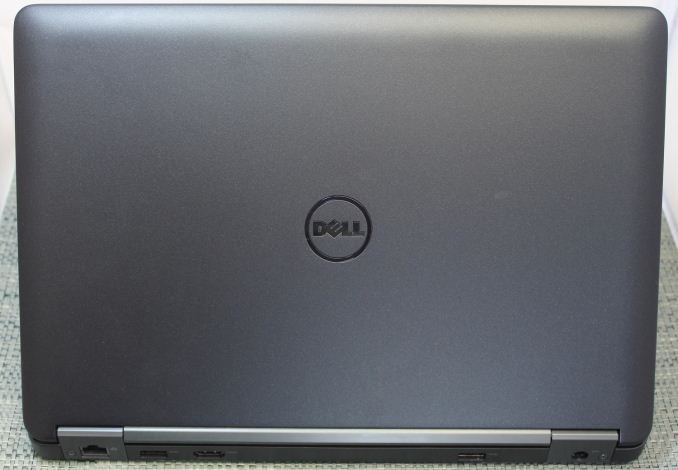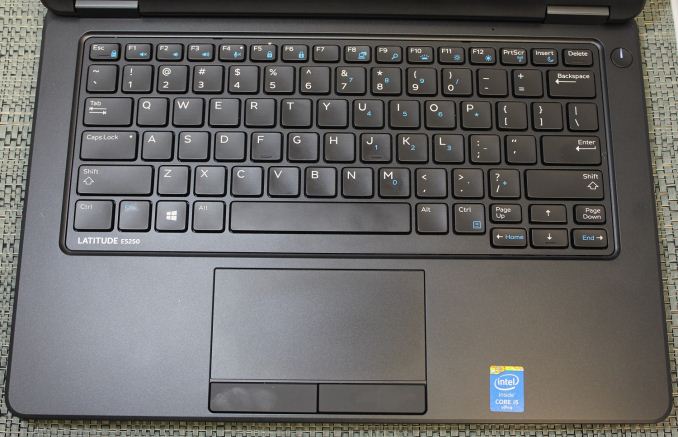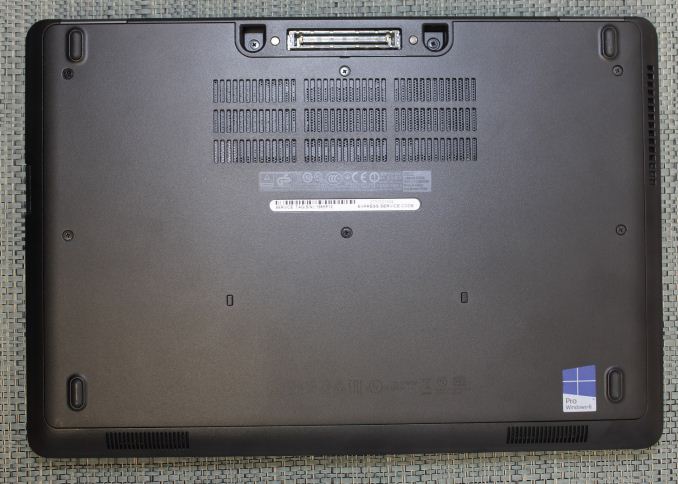Dell Latitude 12 5000 Series Review
by Brett Howse on January 19, 2015 10:30 AM ESTDesign
The Latitude 5000 series does not have the sleek lines of an ultrabook, but rather the understated look of a business class PC. The exterior of the device is matte black, with a soft touch top. The hinge will open 180° but the device does not sit flat when opened to that degree. Overall, it is a fairly pedestrian design as compared to some of the flashier devices sold by others, but it would not look out of place in a board meeting. I am a fan of smaller laptops, so the 12.5 inch model is a good fit personally, but those wanting more real estate can look at the 14 and 15 inch models that are also available.
One thing that stands out on the E5250 model is the amount of display bezel, which feels even more pronounced after seeing the Dell XPS 13 at CES. The sides are not too bad on this laptop, but the top and bottom bezels are very large in order to cover the keyboard and trackpad. There is so much space there that the device is almost asking to have a taller display available, but it seems like the 16:10 display fight has been lost. It is really too bad, especially on a business notebook where spreadsheets and documents would really benefit from the taller display, as opposed to consumer versions where they may be used with more video content. It is hard to fault Dell here though, as it is likely the availability of 16:10 displays has diminished quite a bit, but Apple is still outfitting its laptop line with 16:10 so they are still out there.
One positive element from Dell is the keyboard. Another benefit of not going for the slimmest device ever made is that there is sufficient room to fit a good keyboard. The keyboard in the Latitude E5250 is to be commended with good travel, solid feel, and a nice amount of resistance. It is one of the highlights of this device, especially after becoming accustomed to the keyboards in a traditional ultrabook. The model we received does have optional backlighting but my only complaint with the backlighting is that it does turn itself off rather quickly. Swiping the trackpad will bring the lights back on, and the timeout is configurable in Dell's software.
Speaking of the trackpad, it is one of the better trackpads I have used. ALPS seems to be the maker, and Dell has their own custom software to configure it. The trackpad has a textured surface that is very easy to glide over but at the same time precise. It is not a clickpad either, with dedicated left and right click buttons underneath the trackpad. I personally prefer this, but it does give up trackpad real estate and on a smaller laptop like this it does restrict how large the trackpad can be. It is still a good device though, with smooth motion and accuracy that many devices lack. The trackpad supports up to four finger gestures, but out of the box only one and two finger gestures are enabled.
While the design of the Latitude 12 5000 is not as stunning as other devices like the XPS 13, it carries itself as a no-nonsense work machine, which is what it aims to be. All of the functional aspects of the device are top notch, with a positive keyboard and trackpad, and the thicker chassis allowing a real Ethernet port as well as a docking port. The weight is reasonable but not as light as some consumer focused devices. One aspect to push it on a more positive note would be if it was available as a 16:10 device as well.














48 Comments
View All Comments
DanNeely - Monday, January 19, 2015 - link
Poking around on Dell's website, it appears that the pointy stick is only offered on 14" or larger models; and the only Latitude line to still offer full power mobile CPUs is the 6000 series. Since the latter are all still last years 6x40 models, it's possible that only reflects their not having been refreshed yet instead of a deliberate decision to keep a more powerful CPU (and optional dGPU) available for business customers outside of the Precision line.nerd1 - Monday, January 19, 2015 - link
Ulv processors nowadays have very high base clock so theres no real need for full voltage one. Mbp 13 also uses ulv cpu.DanNeely - Monday, January 19, 2015 - link
Intel's 37-57W Quadcore Haswell i7's have base frequencies about 1ghz higher (2.2-3.1ghz) than the 17W dual models (1.5-2.1). For anyone who's doing work (compiling medium+ code bases, cad, engineering modeling, etc) that's compute bound not human speed bound; the higher clock rates, extra cores, gpu compute, etc all make a huge difference. The current generation of 2 core ULV laptops are all downgrades from the ~2-3 year old laptop I'm using at worknerd1 - Tuesday, January 20, 2015 - link
It's 2015 now, and broadwell i5-5200U has 2.2-2.7Ghz clock speed.nerd1 - Tuesday, January 20, 2015 - link
If you are really doing computation bound work why do you even bother with 12" business laptops?You can always get clevo P751ZM with 4Ghz Devil's canyon desktop GPU at almost the same price nowadays.
drgigolo - Tuesday, January 20, 2015 - link
But MBP13 uses 28W TPD parts, not 15W. Which gives room for higher performance, especially on the GPU (even more so when running single channel).nerd1 - Tuesday, January 20, 2015 - link
I have compared MBP 13 base model to XPS 13 i5-5200U model and rMBP had only 5% advantage for computation and 9% advantage for GPU. Of course this will change with rMBP update though.BMNify - Monday, January 19, 2015 - link
1.56kb => 1.56kg on the conclusion page , Dell Latitude 14 7000 series is almost perfect laptop in ultrabook business lineup. Hope you review it.cwolf78 - Monday, January 19, 2015 - link
Agree fully on this. The company I work for is going to the E7440's as their default laptop. We used the E6400, E6410, E6420, then E6430 before going to these. A dramatic leap forward in every aspect except performance (compared to the E6420/30). But the increased battery life, quite operation, and lighter weight are a good trade-off. The E7440 does have all around decent performance, but does tend to bog down with a lot of stuff open (especially CPU intensive tabs in Chrome). We're using the i5-4310U, 8 GB of RAM, 256 GB SSD, and 14" 1080p IPS multi-touch screen.Samus - Monday, January 19, 2015 - link
I appriciate the review simply as a reminder why Dell is increasingly irrelevent. When you consider an HP Probook 430 can be had for $300 in Celeron configuration with better build quality (aluminum/magnesium chassis, thinner, lighter.) Dell's charging Elitebook prices for this thing. HP and Lenovo are just killing it while Dell is still making laptops styled from the 90's.